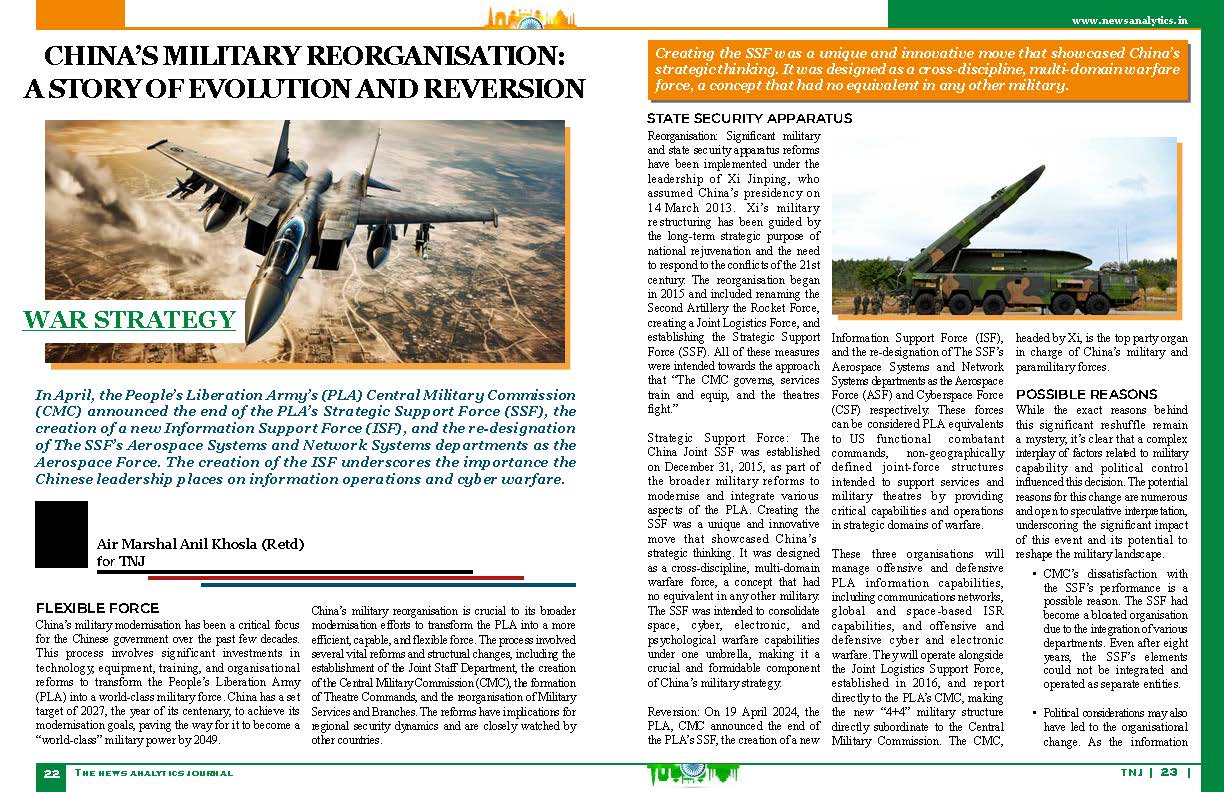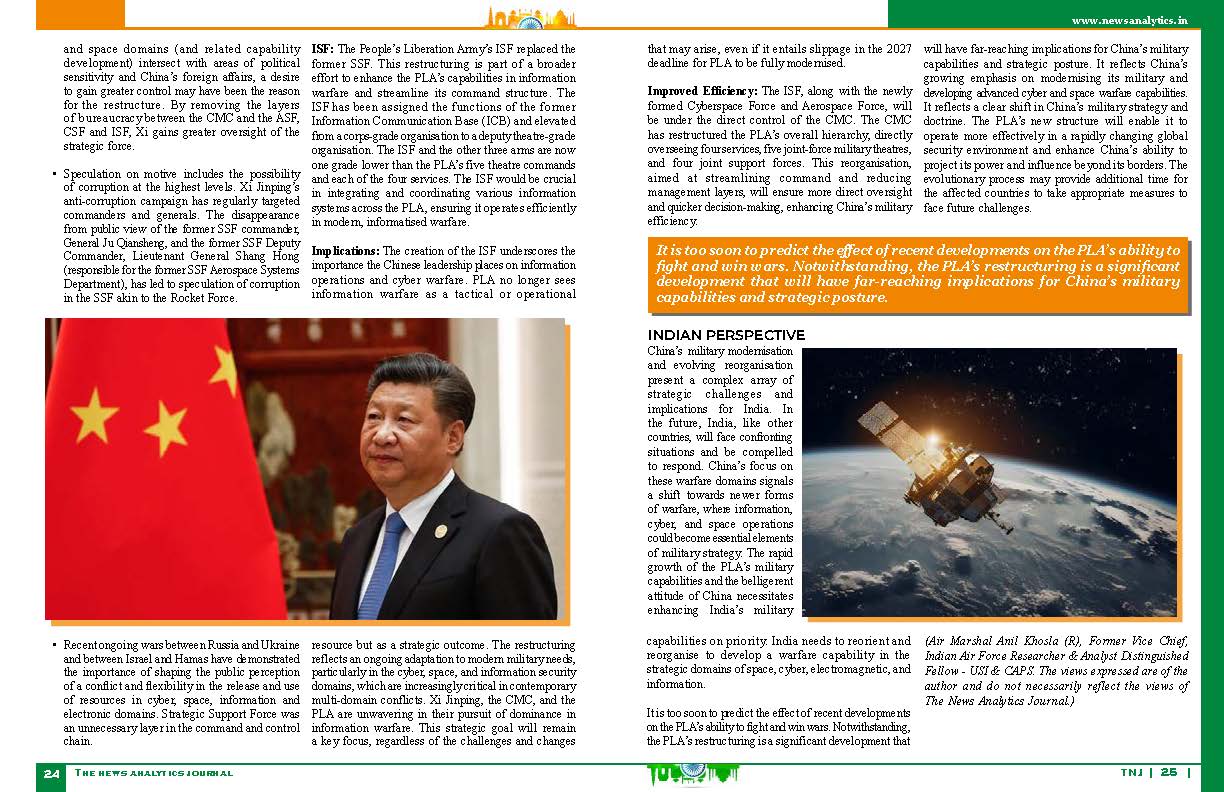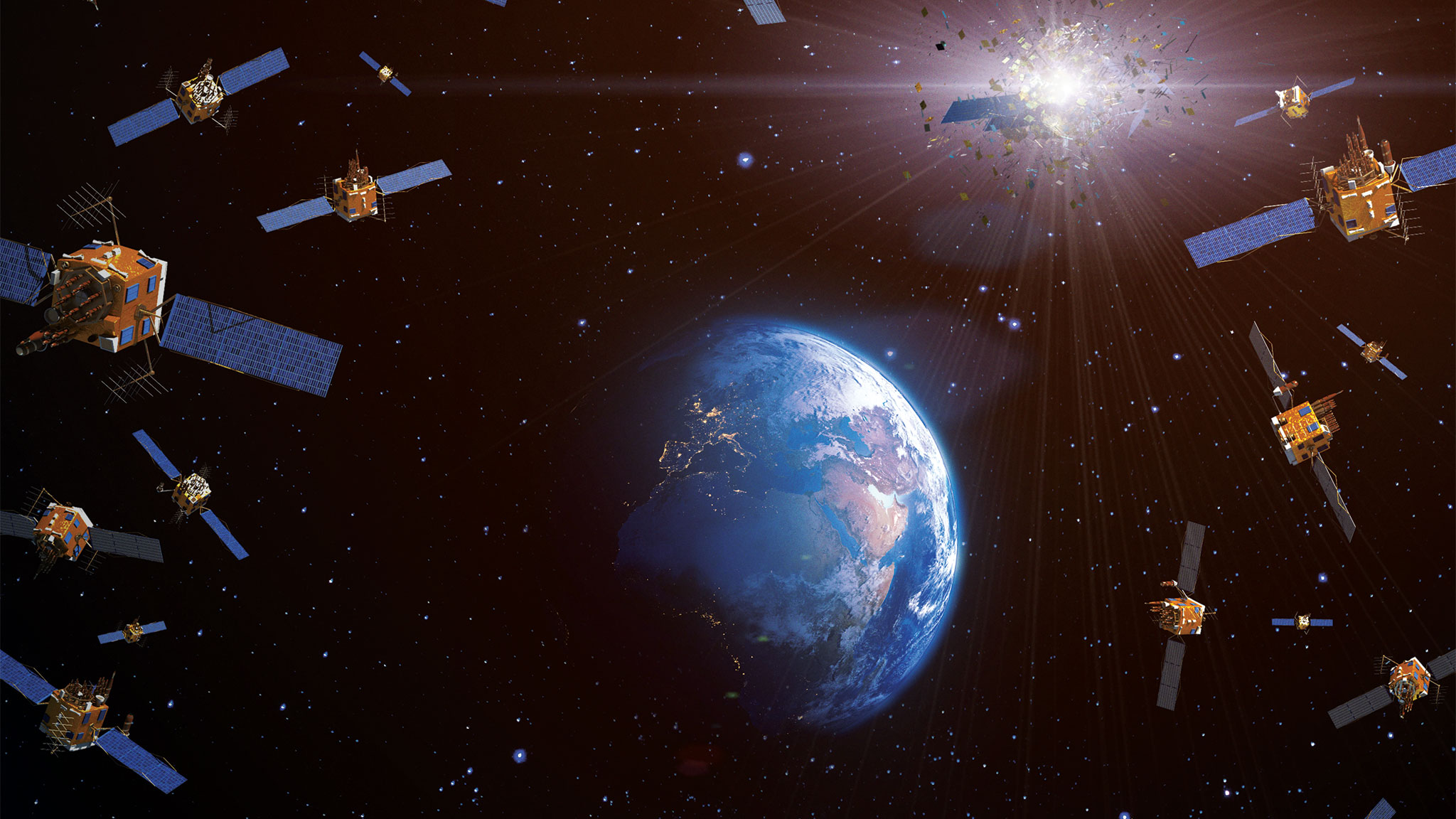
Pic Courtesy Net
My Article published on the Indus International Research Foundation
on 06 Dec 24.
As nations increasingly recognise the strategic importance of space, the implications of space-based technologies and strategies for future warfare have come into sharp focus. The militarisation of space has evolved from a speculative concern to a pressing reality, with countries investing heavily in capabilities that leverage space for national security and military advantage. This article explores the implications of space-based technologies and strategies for future warfare, examining their potential impact on military operations, geopolitical dynamics, and international security to illuminate the challenges and opportunities presented by the rise of space in the defence landscape.
Evolution of Space-based Military Capabilities. Military interest in space can be traced back to the Cold War when the United States and the Soviet Union recognised the strategic advantages that space capabilities could confer. The launch of Sputnik in 1957 marked the beginning of the space race, leading to significant advancements in satellite technology, reconnaissance, and missile defence systems. In the decades since, space has become integral to military operations. Satellite systems provide crucial communication, navigation, reconnaissance, and surveillance support. For example, the Global Positioning System (GPS) has revolutionised military navigation and targeting capabilities, enabling precision strikes and enhancing situational awareness on the battlefield.
Recent Developments. In recent years, the pace of technological advancements in space has accelerated dramatically. Emerging technologies such as miniaturised satellites, space-based sensors, and the potential for its weaponisation are reshaping the strategic landscape. Notably, the rise of commercial space ventures has democratised access to space, allowing non-state actors to contribute to military capabilities. The future of warfare will be defined by the ability to operate seamlessly across domains, including space. This underscores the growing importance of space in contemporary military strategy.
Strategic Implications of Space-based Technologies

Pic Courtesy Net
“The ability to see through clouds and darkness allows for persistent surveillance that can transform battlefield dynamics”.
– Dr Peter Hays, a space policy expert
Enhanced Intelligence, Surveillance, and Reconnaissance (ISR). Space-based technologies significantly enhance a military’s ability to gather intelligence, conduct surveillance, and perform reconnaissance. Satellites with advanced sensors can provide real-time data on enemy movements, infrastructure, and operational capabilities. For instance, the U.S. military’s use of the National Reconnaissance Office (NRO) satellites during the Iraq War exemplified the impact of space-based ISR capabilities. These satellites provided critical intelligence that informed tactical decisions, contributing to the success of operations. Moreover, emerging technologies such as synthetic aperture radar (SAR) enable all-weather surveillance, further enhancing the effectiveness of ISR missions.
Space-based Navigation and Timing. Navigation and timing capabilities provided by space assets are essential for modern military operations. Initially developed for military applications, GPS technology is now a cornerstone of military operations worldwide. Accurate positioning allows for effective force coordination, precision targeting, and enhanced logistical operations. In conflicts such as the Gulf War and the War in Afghanistan, GPS-guided munitions have played a pivotal role in achieving tactical objectives with minimal collateral damage. However, reliance on space-based navigation systems also introduces vulnerabilities. Adversaries can employ jamming or spoofing techniques to disrupt GPS signals, potentially crippling military operations. The need for redundancy in navigation systems and the development of alternative technologies is becoming increasingly vital.
Space-based Communication. Satellite-enabled communication systems facilitate real-time information exchange among military units, command centers, and allied forces. Secure, reliable communication is essential for effective coordination and decision-making in modern warfare. Satellite communication (SATCOM) systems have become ubiquitous in military operations, enabling troops in remote areas to maintain contact with command and control centers. However, increasing reliance on satellite communication raises concerns about cyber threats and electronic warfare vulnerabilities.
Potential for Space-based Weapons. The prospect of weaponising space has generated significant debate among military strategists and policymakers. While the Outer Space Treaty of 1967 prohibits the placement of nuclear weapons in space, the development of conventional weapons systems designed to operate in or from space raises ethical and strategic concerns. Various concepts for space-based weapons are being explored, including missile defence systems and directed energy weapons. The Strategic Defence Initiative (SDI) proposed during the Reagan administration exemplifies the historical interest in space-based defence systems. Moreover, China and Russia are actively pursuing anti-satellite (ASAT) weapons capable of targeting and neutralising enemy satellites. The potential for space-based weapons creates a new dimension of conflict, where controlling space assets becomes a critical strategic objective.
Geopolitical Dynamics and Space-based Warfare

Pic Courtesy Net
Space as a Theatre of Conflict. The increasing militarisation of space has transformed it into a potential theatre of conflict. Nations recognise that control of space assets can significantly influence the outcome of terrestrial conflicts. The competition for dominance in space is not limited to traditional military powers; emerging space-faring nations are also seeking to establish their presence. India’s successful test of an ASAT weapon in 2019 demonstrated its growing capabilities in space warfare. The test raised concerns among regional adversaries.
Space Diplomacy and Treaties. Space becomes an arena for potential conflict, so the importance of diplomacy and international agreements cannot be overstated. Establishing norms and regulations governing space activities is critical to preventing escalation and ensuring responsible behaviour among nations. The Outer Space Treaty and the 1972 Anti-Ballistic Missile Treaty are examples of agreements promoting peace in space. However, as technological advancements evolve, there is a pressing need for updated frameworks that address contemporary challenges. Discussions around establishing a “Code of Conduct for Outer Space Activities” have gained traction recently. This initiative aims to promote responsible behaviour in space and prevent conflicts arising from misunderstandings or miscalculations.
Space Alliances and Partnerships. In evolving geopolitical dynamics, nations increasingly form alliances and partnerships to enhance their space capabilities. Collaborative efforts can improve technological development, share intelligence, and foster interoperability among allied forces. NASA’s establishment of the Artemis Accords in 2020 exemplifies this trend. The accords promote international cooperation in space exploration and outline principles for sustainable exploration of the Moon, Mars, and beyond. NASA Administrator Jim Bridenstine states, “We must work together to ensure that space is a peaceful domain for all humanity” (Bridenstine, 2020). Moreover, NATO has recognised the significance of space in collective defence strategies. The 2019 NATO Space Policy emphasises the need for member states to enhance their space capabilities and improve coordination in space operations (NATO, 2019). This commitment to collaboration underscores the understanding that space security is a shared responsibility.
Challenges and Risks Associated with Space-based Warfare
Space Debris and Collision Risks. As the number of satellites in orbit grows, the risk of space debris and collisions poses significant challenges. Collisions between satellites or debris can create catastrophic consequences, rendering space assets inoperable and potentially jeopardising military operations. The European Space Agency (ESA) estimates that over 34,000 pieces of debris larger than 10 centimeters are in orbit, with millions of smaller fragments posing threats to operational satellites. The risk of collisions not only threatens national security assets but also raises concerns about the sustainability of space activities.
Cyber Security Threats. As military reliance on space-based technologies increases, the vulnerability of these systems to cyber threats becomes a pressing concern. Cyber attacks can target ground control stations, communication links, and satellites themselves, undermining the integrity of space operations. In 2020, the Russian military conducted a cyber exercise simulating attacks on U.S. satellite systems, highlighting the potential for adversaries to disrupt critical space capabilities. Ensuring robust cyber security measures for space assets is essential to maintain operational readiness and protect sensitive information.
“We must avoid actions that could lead to an escalation in a domain where the stakes are incredibly high.”
– General John Raymond
Escalation and Miscalculation. The militarisation of space raises the risk of escalation and miscalculation in conflicts. As nations develop capabilities to target each other’s space assets, the potential for conflict increases. A misstep or misunderstanding could lead to unintended consequences and broader military confrontations. Diplomatic efforts to establish norms of behaviour and prevent escalation are critical in mitigating these risks.
Case Studies of Space-based Warfare Implications
The Gulf War and the Role of Satellites. The Gulf War (1990-1991) serves as a crucial case study in understanding the implications of space-based technologies in modern warfare. The U.S.-led coalition leveraged satellite intelligence, surveillance, and reconnaissance capabilities, significantly enhancing operational effectiveness. Satellite imagery allowed coalition forces to assess Iraqi troop movements, monitor logistics, and plan airstrikes with precision. The use of GPS-guided munitions further demonstrated the transformative impact of space technology on military operations. The ability to use satellites for real-time intelligence fundamentally changed the war’s course.
Ukraine Conflict and Space-based Surveillance. The ongoing conflict in Ukraine highlights the significance of space-based surveillance in contemporary warfare. Both Russia and Ukraine have utilised satellite technologies for reconnaissance and intelligence-gathering purposes. The use of commercial satellites for monitoring troop movements and assessing battlefield conditions has become increasingly prevalent. Moreover, the conflict underscores the vulnerabilities associated with space-based technologies. Russia’s reported jamming of GPS signals in contested areas raises concerns about the reliability of navigation systems for military operations.
China’s Space Ambitions and Military Modernisation. China’s rapid advancements in space capabilities have significant regional and global security implications. The country’s focus on developing anti-satellite weapons, satellite constellations, and manned space missions reflects its ambition to establish itself as a significant space power. China’s successful test of an ASAT weapon in 2021 demonstrated its growing capabilities to target and neutralise enemy satellites. China’s military modernisation efforts emphasise integrating space capabilities into its defence strategy.
The implications of space-based technologies and strategies for future warfare are profound and multifaceted. As nations invest in space capabilities, the strategic landscape is evolving, presenting opportunities and challenges. Enhanced intelligence, surveillance, and communication capabilities are transforming military operations, while the potential for space-based weapons raises ethical and strategic concerns. Geopolitical dynamics are shifting as nations vie for dominance in space, prompting discussions around treaties, alliances, and responsible behaviour. However, challenges such as space debris, cyber security threats, and the risks of escalation underscore the need for caution and international cooperation. As we look to the future, it is clear that space will play an increasingly pivotal role in shaping the nature of warfare. Acknowledging the complexities and responsibilities associated with space activities is essential for ensuring that space remains a domain for peaceful cooperation rather than conflict.
Your valuable comments are most welcome.
Link to the article:
https://55nda.com/blogs/anil-khosla/2024/12/06/549-space-power-shaping-future-conflicts/
For regular updates, please register your email here:-
References and credits
To all the online sites and channels.
References:
- Bridenstine, J. (2020). NASA Administrator Jim Bridenstine on the Artemis Accords. NASA.
- Department of Defense. (2021). Annual Report to Congress: Military and Security Developments Involving the People’s Republic of China 2021. Retrieved from defense.gov.
- Department of Defense. (2022). National Defense Strategy. Retrieved from defense.gov.
- European Union. (2020). The EU Space Strategy for Security and Defence. Retrieved from europa.eu.
- Fedorov, M. (2022). Vice Prime Minister of Ukraine on Satellite Imagery. Ukrinform.
- Friedman, G. (2020). The Future of Warfare: China, Russia, and the New Space Race. Geopolitical Futures.
- Ghosh, A. (2019). India’s ASAT Test: Implications for National Security. The Diplomat.
- Hays, P. (2021). The Future of Space Operations: Technology and Strategy. Air & Space Power Journal.
- Moseley, T. M. (1992). The Air Campaign in the Gulf War. Air Force Historical Studies Office.
- NATO. (2019). NATO Space Policy. Retrieved from nato.int.
- Raymond, J. W. (2020). Chief of Space Operations on the Future of Space Warfare. U.S. Space Force.
- U.S. National Reconnaissance Office. (2021). NRO Support to Military Operations. Retrieved from nro.gov.
- U.S. Space Command. (2020). Threats to U.S. Space Assets. Retrieved from spacecom.mil.
- Waugh, W. (2021). Space Debris: A Growing Concern for National Security. Space Policy Journal.
Disclaimer:
Information and data included in the blog are for educational & non-commercial purposes only and have been carefully adapted, excerpted, or edited from reliable and accurate sources. All copyrighted material belongs to respective owners and is provided only for wider dissemination.



